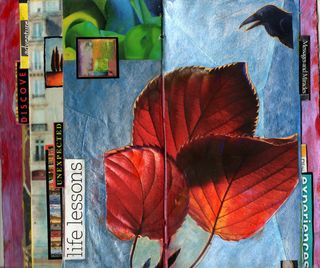Creativity
Creativity and Emotional Well-Being: Recent Research
Engaging your creative self has more benefits than you think.
Posted December 29, 2016

For readers who are interested in how and if creative engagement can affect general well-being, two recent studies clarify just how creativity impacts emotional health in particular. One study examines the relationship between creative activities and positive outlook; the second explores the possibility that creative endeavors may actually buffer anxiety related to the inevitability of death.
Creativity and Positivity. Grumpy much? A recent study in the Journal of Positive Psychology (Tamlin, Conner, DeYoung & Paul, 2016) indicates that engaging in a creative activity just once a day can lead to a more positive state of mind. Researchers at the University of Otago constructed a study to understand if creativity impacts one’s emotional well-being, based on the growing belief that there is a connection between creativity and emotional functioning. To test this hypothesis, they evaluated the responses of 658 young adults; each day the participants documented how much time they spent on creative endeavors as well as the positive and negative emotional changes they perceived.
After 13 days, the researchers reviewed the participants’ responses and discovered an “upward spiral for well-being and creativity” in those individuals who engaged in daily creative pastimes. In brief, creative activities provided a measurable boost in positive affect during the following day. The researchers also examined participant data from a “flourishing scale” that asked individuals to rank responses to various questions such as “Today my social relationships were supportive and rewarding.” These rankings correlated to creative engagement, implying that creativity may, in fact, impact both happiness in social relationships and positivity in the workplace.
How does this translate from research to practical application? A creative activity can be as simple as keeping a doodle journal, knitting, playing a musical instrument, or designing a garden for spring planting-- in other words, activities that almost anyone can do. So express yourself in some way you enjoy on a regular basis, just once a day and benefit from a more positive state of mind. In other words, being creative helps us “feel better” and in turn, it impacts other aspects of our lives.
Creativity and Mortality. This second study (Perach & Wisman, 2016) explores an interesting question: Can creative endeavors buffer anxiety about death? While there have been other studies attempting to correlate creativity with increased life span, psychologists at the University of Kent examined levels of creative achievement and ambition in a group of 108 students to clarify the role of creative contributions in mediating apprehension and dread about one’s demise. The participants completed two questionnaires to measure their levels of creative engagement and perceptions of personal creative ambition. Those individuals with a record of creative achievement and who had high levels of creative ambition made less “death associations” after thinking about their own death.
Based on outcomes from this study, researchers Perach and Wiseman suggest that those individuals who pursue creative endeavors and produce what they perceive to be significant creative contributions may experience more internal security in the face of death than those who do not. One way to interpret this implication derives from studies of the contributions of well-known creative people; for example, according to the researchers artists such as Nobel Prize winner Bob Dylan and the late Leonard Cohen are believed to be motivated by a goal of leaving an enduring legacy through their output. But for those of us who are not in the same league as Dylan or Cohen, the results of this study may suggest another more universally promising upshot of creative engagement. Sociologist Brene Brown captures this universality, noting “The only unique contribution that we will ever make is this world will be born of our creativity.” Or, as I like to believe, to use our creativity and imagination, even in simple ways, is an affirmation of life.
Be well and bring some creativity into your life,
Cathy Malchiodi, PhD
©2016 Cathy Malchiodi, PhD
References
Perach, R. and Wisman, A. (November, 2016), Can Creativity Beat Death? A Review and Evidence on the Existential Anxiety Buffering Functions of Creative Achievement. The Journal of Creative Behavior. doi: 10.1002/jocb.171.
Tamlin S. Conner, Colin G. DeYoung & Paul J. Silvia (November, 2016): Everyday creative activity as a path to flourishing, The Journal of Positive Psychology, DOI: 10.1080/17439760.2016.1257049. To download a copy of this article for a limited time from the publisher: http://dx.doi.org/10.1080/17439760.2016.1257049
Update: Here is another resource-filled link on how the arts improve lives at createquity.com.
Visit my updated website at www.cathymalchiodi.com for article downloads, podcasts and other resources on the arts, creativity, art therapy, and expressive arts therapy for health and well-being.


